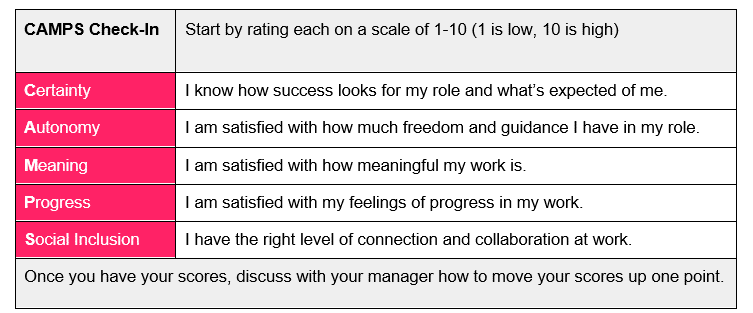Managing employee engagement has its challenges and even more so now that many workplaces have been forced to go remote. Now, employees are experiencing different levels of engagement for a variety of reasons.
Many workers are now forced to share their home office with their spouses and children, who are also forced to stay home, and managers aren’t as easily able to keep track of their staff like they could in the office. Being able to see how your workers are coping makes management slightly easier because you are able to see body language.
With remote work, managers do not have the same luxury of picking up on visual cues, so they must rely on constant communication to get a pulse on how engaged their staff is. Fortunately, there’s a model leaders can use to better gauge their staff’s level of engagement.
CAMPS Model
While researching this topic, I stumbled upon a “dad joke” that was pretty fitting for the times: “I built an emergency shelter out of cereal boxes. I called it my snap, crackle, and pop-up tent.” Yes, I just made a pun about camping to introduce LifeLabs Learning’s model for measuring engagement.
LifeLabs Learning, a leadership development company that helps managers, executives, and teams master life’s most useful skills, has developed a model to gauge engagement at work called the CAMPS Model.
According to LifeLabs, the CAMPS Model is based on the human brain’s five biggest cravings. It’s a quick gauge to check which “camp” someone is in: engaged or disengaged. Company leaders can use it as a pulse-check for themselves and with those they are leading and supporting.
This model would also be of great use for executives, HR departments, and even managers who are looking for a little guidance on how to support their teams during this pandemic.
How Does It Work?
According to Diane Sadowski-Joseph, Director of Facilitator Development at LifeLabs Learning, “the CAMPS model is a simple way for managers to diagnose and root out engagement issues faster.” She provides an example of how the model is used in practice:
To use the CAMPS Model, have managers ask their individual team members: “On a scale of 1-10, what’s your CAMPS score today in each bucket?” The score is based on the team members’ feeling of satisfaction in each area at that moment.
When broken down, a “1” means that “bucket” is a huge problem area for them, while a “10” means satisfaction is very high. “For example, on a day where a project I was working on got cancelled I give a score of ‘3’ in feelings of progress,” Sadowski-Joseph explains. “On a day where I finished a project I might be a ‘9’ in feelings of progress.”
“The scores allow managers to focus the conversation on the areas that are most impacting that person’s engagement AND to quickly come up with solutions that address the root cause rather than the surface issue,” she adds.
“For example, on the day I’m a ‘3’ in progress, my manager might ask ‘what would move that score up one point,’ which gets us into a conversation on how we can boost my feelings of progress overall,” Sadowski-Joseph explains. “This is a much deeper and more useful conversation than venting about the complaint du jour.”
Below is a chart that illustrates what a CAMPS check-in could look like:
Improving CAMPS Scores
While it’s great when employees are able to give “10s,” realistically, we know that won’t happen for every project or “bucket.” In order to increase scores in problem areas, here are some suggestions to follow.
For low scores under the “Certainty” bucket, LifeLabs suggests the following ways to raise these scores:
- Acknowledge shared feelings of uncertainty.
- Keep one-on-ones and team meetings consistent.
- Create individual and team rituals.
- Communicate on a predictable cadence.
- Focus on what is in your scope of control.
For low scores under “Autonomy,” you can try:
- Providing employees with a choice of responsibilities
- Asking if more guidance is needed
- Inviting people to co-create solutions
- Offering work schedule options, if possible
- Clarifying what each person is the “CEO” of
For “Meaning,” leaders can:
- Link work to the team or company mission.
- Share feedback from customers/users.
- Craft tasks to align with personal values.
- Create a team gratitude norm.
- Call out people’s contributions.
For “Progress”:
- Acknowledge grief of lost hopes of plans.
- Reset a small number of top priorities.
- Focus on results vs. hours worked.
- Shorten milestones to celebrate small wins.
And finally, for the “Socialness” bucket, here are a few ways to raise employees’ scores:
- Ask about feelings and individual needs.
- Check in just to say hi!
- Encourage cameras on (don’t mandate it).
- Welcome kids, pets, and cohabitators.
- Create social collisions (e.g., chat roulette, standups, games, photo shares, etc.).
While remote work may seem like the new norm for now, who knows what the future has in store. But leaders who adopt the CAMPS Model will be equipped with a clear understanding of just how engaged your workers are. What other methods have you successfully implemented to keep your workers engaged while working from home? Share your stories in our comments section below.
The post CAMPS Model: A Method to Better Understand Employee Engagement appeared first on HR Daily Advisor.

